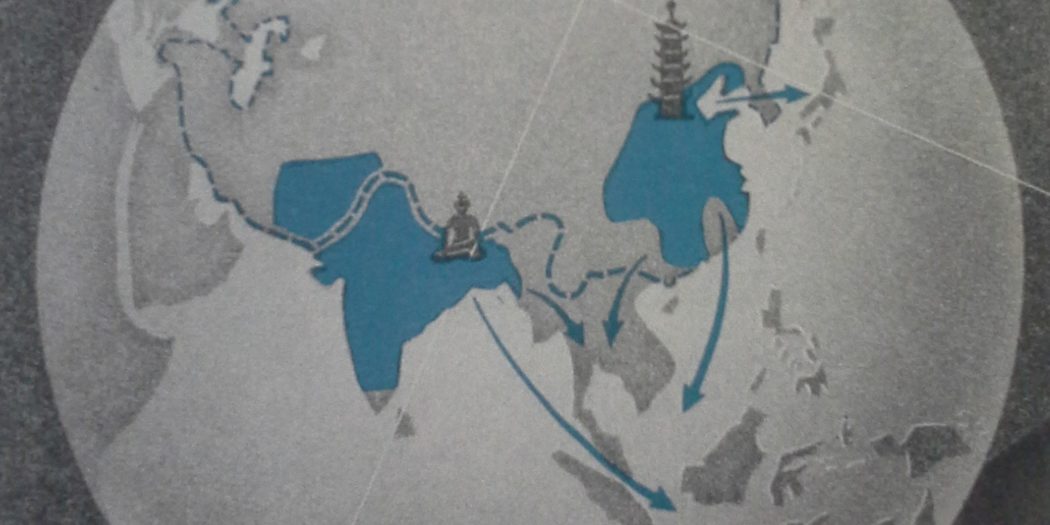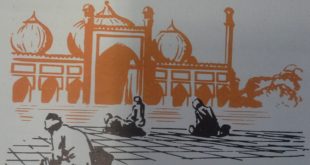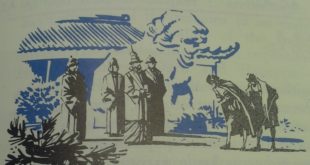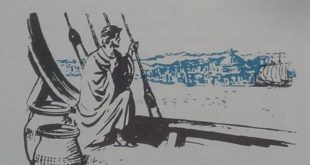Two hundred years before Columbus discovered America, a certain Marco Polo told strange, exciting stories to his friends and neighbours in Venice, a city in northern Italy. He had travelled, he said, to distant lands in Asia and had become rich. Europeans at that time had some general knowledge of eastern Asia and of its products, but Polo furnished detailed and colourful descriptions of magnificent cities, of strange customs and of powerful rulers who owned many palaces and lived in unheard of luxury.
Marco Polo had visited the court of the khan, or ruler, of an empire that included most of east Asia as well as great islands in the Pacific and Indian Oceans. Polo had been made a public official. He had been sent on errands to the cold wastes of present day Siberia and the green Spice Islands where it was always warm. He had seen civilizations of many kinds — some primitive, some more magnificent than those in Europe.
Marco Polo’s stories were so amazing that not until long after his death did most people believe them. “How,” thought Europeans, “could Asians have travelled so far on the long road from savagery without our help?”
Today we know that Marco Polo’s stories were true, atleast in all important respects. We know that while Egyptians were building their pyramids and the Sumerians their temple towers in Mesopotamia, civilization was growing in India. We know also that while the Greeks and Romans were creating “the glory that was Greece and the grandeur that was Rome,” the Chinese were developing their own civilization and way of life. You will not find the empire of Alexander or the Roman Empire on a modern map of the world, as you know, but India and China still exist. Many changes have taken place over thousands of years, but the civilizations of these two countries, deeply rooted in the past, have continued. Both India and China play important roles in the world today.

We take a look at the beginnings and early development of India.
1. What influences contributed to the growth of early India?
2. What kind of civilization grew up in early India?
1. What influences contributed to the growth of ancient India?
India is part of the vast continent of Asia. The Indian penninsula is shaped like a triangle with its base attached to the southern part of Asia. Often referred to as “the subcontinent of Asia,” the peninsula is somewhat less than half as large as the United States but its population is close to three times as large. Today this region includes the Republics of India and Pakistan.
Along India’s northern borders rise the world’s loftiest mountains, the Himalayas and the Pamirs, “the roof of the world.” Down from the glaciers in these tremendous mountain ranges pour great rivers onto the broad open plain of northern India. One such river is the Indus; another is the Ganges; a third is the Brahmaputra far to the east, which joins the Ganges near its mouth and shares its delta.
South of the great plain lies the rest of India’s triangle, a tapering peninsula fringed by mountains. Between these mountains and the sea are narrow coastal plains. The coastal plain on the eastern side faces the Bay of Bengal. On the west, the coastal region looks out on the broad Arabian Sea. In general, the climate of India is hot and humid, except in the highlands and mountains. The rainfall varies throughout India from the heaviest in the world to amounts so small that farming is difficult or impossible without irrigation. The most fertile part of India is the northern plain. There live most of India’s people. There most of India’s long history of invasion and conquest and ever changing civilization has taken place.
The Indus valley was one of the “cradles of civilization.” A traveller who visits India will find ways of living which to him seem strange. These customs have grown up over more than 5000 years and have been developed by many peoples. Archeologists have discovered the remains of an early civilization in the valley of the Indus River. The inhabitants of two impressive cities — Mohenjo Daro and Harappa — and at least a hundred other villages and towns developed Bronze Age ways of living. These towns and cities must have had contacts with the Mesopotamian area. In Sumerian cities, archeologists have dug up products that apparently could have come only from India.
What happened to these ancient centres of civilization in the Indus River valley remains a mystery. For some reason the inhabitants of that river valley deserted their cities about 2000 B.C. Were they fleeing from approaching conquerors? Did famine or disease drive them away? Nobody knows, but the sands of the desert crept into the silent streets and drifted over the houses. The language of those early peoples disappeared with them and little progress has been made in translating their written records.
Indo-Aryans conquered India. Centuties passed after the mysterious disappearance of India’s first civilization in the Indus River valley. Then, by 1500 B.C., waves of fair-skinned invaders called Indo-Aryans had begun to roll into India. They came from the high plains of Persia on the west. In fact, the Persian name for India was Hindustan, which comes from the name Hindu and means “Land of the Hindus.”
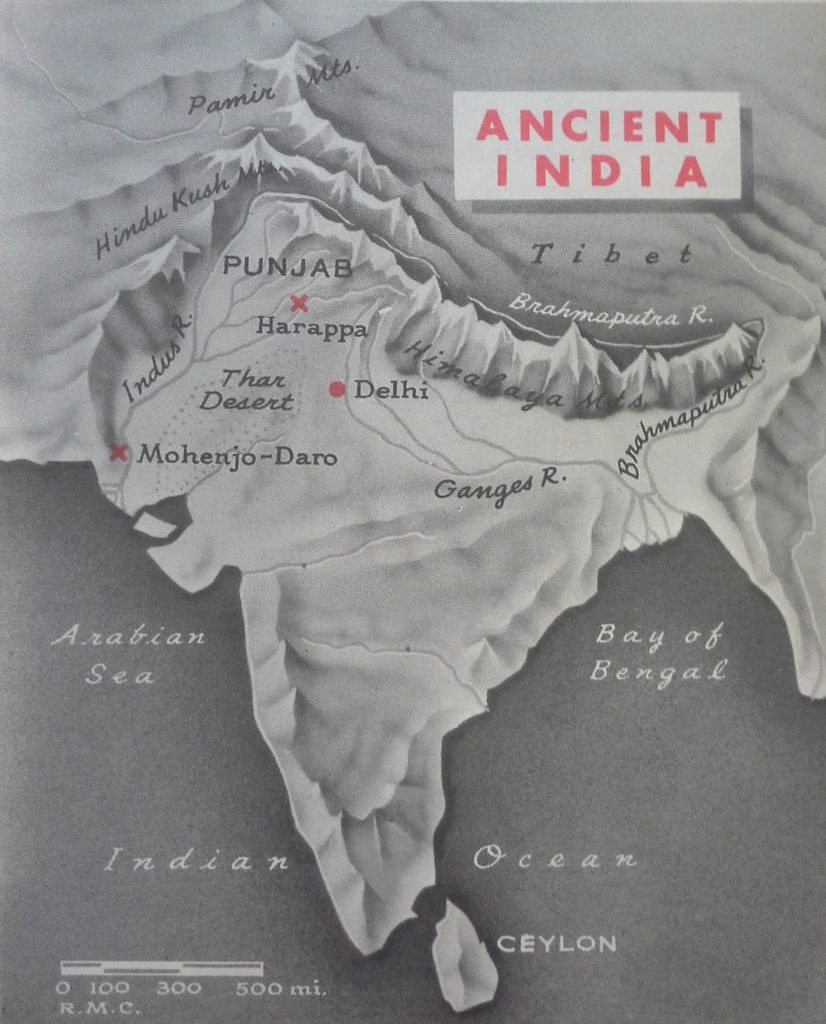
Wave upon wave of these Indo-Aryan warriors invaded India. They poured down through the windy mountain passes and onto the broad plain of the Indus valley. At first they settled in the Punjab, the area of the five rivers which feed the Indus. Later on they spread eastward into the basin of the Ganges River. They overcame an earlier people called Dravidians whom they found living in northern India. Those Dravidians who did not flee southward were made subjects, but the early Indo-Aryans did not unite India under a single ruler. Instead they created separate states headed by rajahs, or petty kings. There was constant warfare between the various Indo-Aryan states.
The lndo-Aryans created a flourishing civilization. The earliest Indo-Aryans were an agricultural people. They used crude plows to turn over the soil and sickles to harvest their crops of grain. Skilled craftsmen made utensils, wove cloth and fashioned ornaments. The chief wealth of the Indo-Aryans was in cattle which, unlike the later Hindus, they used for food. As warriors, they fought from horse drawn chariots, used bows and arrows. Gradually the Indo-Aryans developed city life, building high walls around their towns as defenses against enemies.
Knowledge of the early Indo-Aryans comes from the Vedas. The Indo-Aryan invaders of India spoke a language called Prakrit and used a system of writing learned from the Persians. For many generations, however, while the Indo-Aryans were establishing themselves in India, they did little writing. Instead they handed down by word-of-mouth from father to son a collection of hymns, poems and legends. At length Indo-Aryan scholars developed from spoken Prakrit a written language called Sanskrit. Centuries after the Indo-Aryan conquests took place, the collections of literary treasures called Vedas were written down in Sanskrit. (Veda means “Wisdom.”)
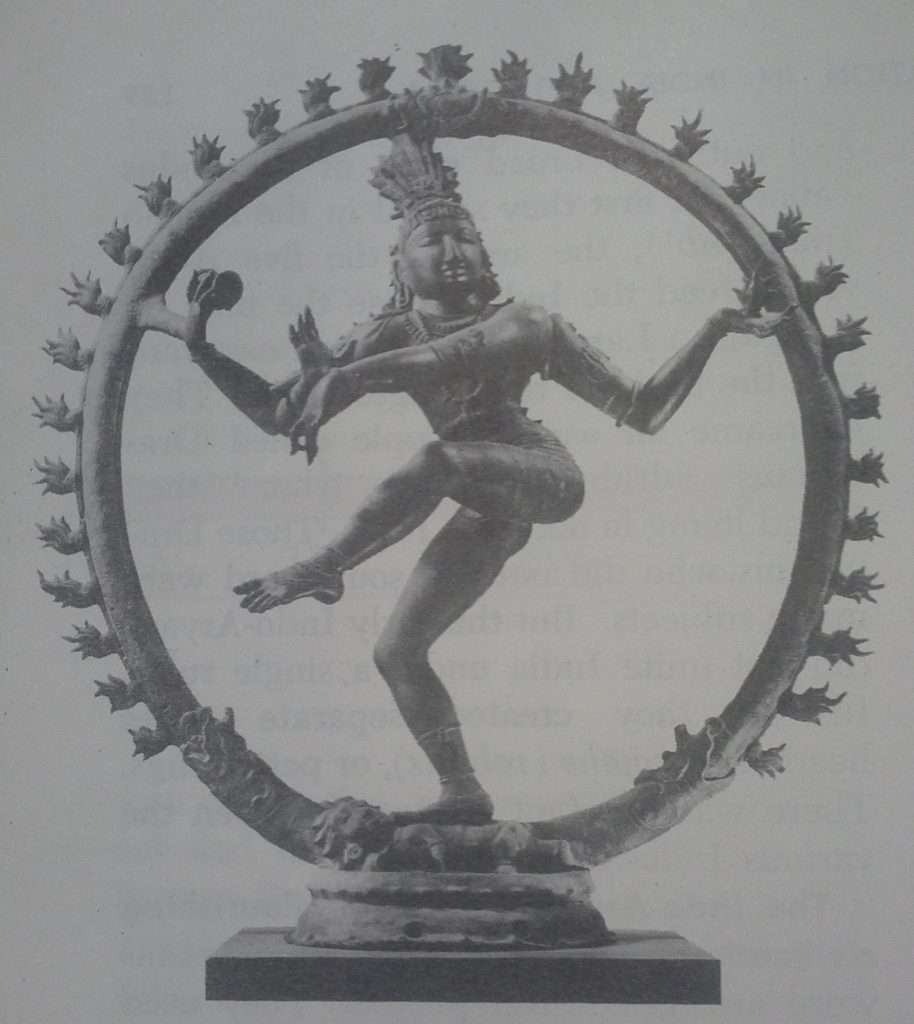
The earliest and most important of the Vedas was the Rig Veda, a collection of more than 1000 hymns. The Vedas, together with long poems of a later time, provide most of our information concerning the early Indo-Aryans. The Vedas not only give us clues to historical events but tell us what kind of people the Indo-Aryans were — vigorous men and women with a love for beauty and a strong religious feeling. The Vedas also make up the sacred books or scriptures of India’s chief religion, Hinduism.
The lndo-Aryans laid the groundwork for Hinduism. The origins of this widespread religion date back to the beginnings of India. Among the early Indo-Aryans, religious ceremonies were so simple that the head of each household could conduct the family’s worship. Gradually a more complicated system developed, with hundreds of gods to be worshiped. Of these gods, the three greatest were Brahma, source of all life and creation; Siva, the destroyer; and Vishnu, the preserver. There were also elaborate ceremonies to be performed and numerous rules to be observed. To interpret this religion and to guide its worship there developed a special class of priests, called Brahmins. Due to the influence of this priestly class, Hinduism is sometimes called Brahminism.
Hinduism laid down rules by which men should strive for perfection. The basic teachings of Hinduism may be summarized as follows;
1. The world is evil and all life is misery. “As long as a man lives he is buried in afflictions,” says one of Hinduism’s early books. “Wife, children, servants, houses, lands, riches contribute more to the misery than to the happiness of mankind. . . . ”
2. Escape from this evil world comes through following the teachings of the
Brahmins and careful performance of one’s duties. At death a man’s soul does not die but is reborn in a new body. The soul of a man who has led a wicked life is reborn in the body of a less fortunate person or even of an animal, but the soul of the man who has led a good life is reborn in the body of a still better person. By living according to the rules and teachings of the Hindu religion, the soul can, through many rebirths, come closer and closer to perfection. This idea of the rebirth of souls is called reincarnation.
3. All life is sacred. “Vishnu is pleased with him who neither beats nor slays anything.” Since souls may be reborn in animals, no living thing should be destroyed. As a result, Hindus do not eat meat. Cows are regarded as particularly sacred and huge numbers of them are to be found throughout India.
4. Living a good life is more important than happiness. Like all the truly great religions, Hinduism stresses good personal conduct. Another of the old books states that Vishnu “is always satisfied with him who is anxious for the welfare of all creations, his children and his own soul.”
The caste system grew out of Hinduism. Closely connected with Hinduism was the caste system, or division of people into separate classes. How the caste system started is uncertain. Possibly it began in the way the Indo-Aryan invaders treated the Dravidians who lived side by side with them. The Indo-Aryans may have feared that by intermarriage or mingling with the Dravidians, they would cease to be a distinct people. The leaders of the Indo-Aryans may therefore have decreed that the Dravidians must live apart and that the Indo-Aryans must have nothing to do with them.
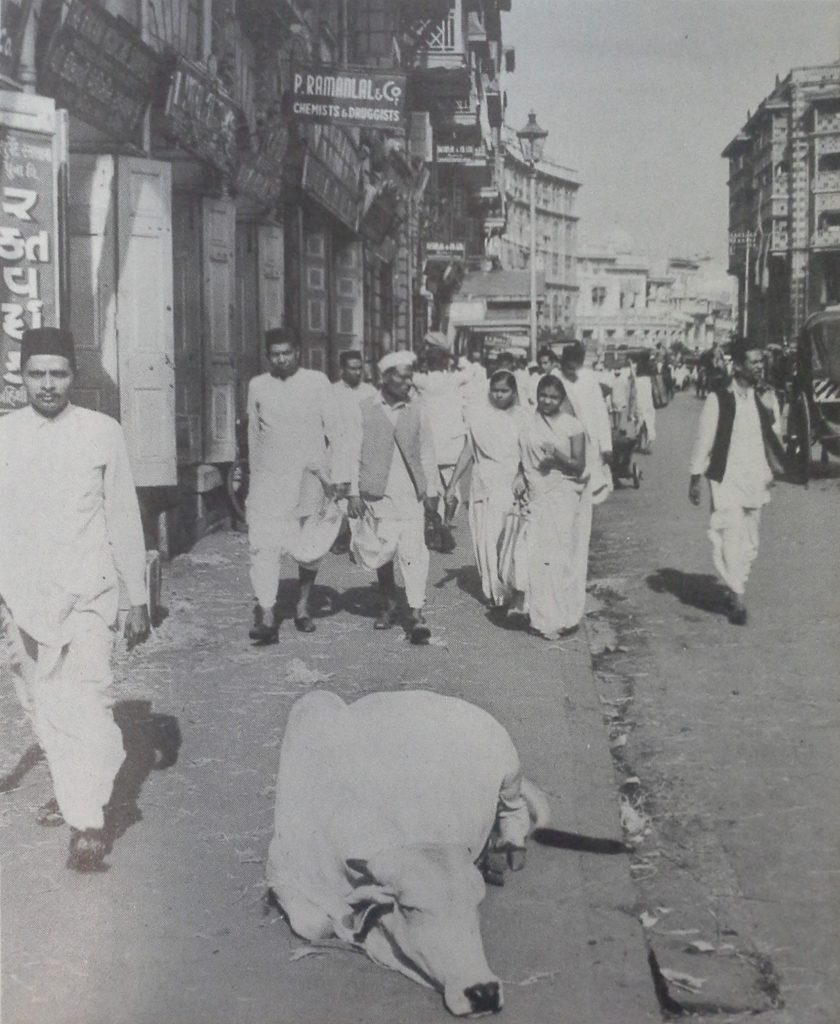
With the growth of Hinduism the caste system became an important part of the life of the Indo-Aryans themselves. The caste system set people apart in four great classes according to their occupations.
(1) The highest caste included the priests or Brahmins. These were the holy men, devoted to lives of study and meditation. The importance of religion gave the Brahmins a position of superiority over all others. (2) Next in rank after the Brahmins were the warriors or rulers. Then came (3) the craftsmen, merchants and farmers; and last of all (4) the labourers. The great mass of people belonged to the lowest caste, that is, the labourers. Within these four major castes, there grew up in time hundreds of subdivisions or castes within castes, usually formed according to occupations.
Finally, entirely outside the castes were the so called untouchables. This unfortunate group, composed of people who had been captured in war or who for some reason had lost caste, had no standing whatsoever. For even the shadow of an untouchable to fall upon a member of any caste was considered a disaster.
EARLY INDIA TIME-TABLE
Height of early Indus Valley civilization, 2500 B.C.
Decline of early Indus Valley civilization, 2000 – 1500 B.C.
Peak of Indo-Aryan invasions of the Punjab, 1500 B.C.
Brahmin period (Vedas recorded, caste system established), 1000 – 600 B.C.
Birth of Buddha (who preached a religion of hope), around 550 B.C.
Alexander the Great invaded northwest India, 326 B.C.
Most of India united under the Mauryas. King Asoka ruled, 269 – 237 B.C.
Golden Age of India under the Guptas, about 300 – 500 A.D.
Invasions of northern India from the north-west, 450 -1500 A.D.
Tamerlane invaded northern India, 1398 A.D.
The Mogul Empire began, 1526 A.D.
These early dates in this Timetable are only approximate.
The caste system was tied up with the religion of Hinduism in two ways. It was encouraged by the priestly Brahmins to help maintain their own position of leadership. It also provided the means by which, in theory, a person might be reincarnated, or born again, at a higher level. Among the many rules connected with the caste system were these: (1) A person must remain within the caste in which he was born. (2) A member of one caste must not eat with a member of another caste. (3) Persons of different castes could not intermarry. No amount of good deeds could enable a man to change from one caste to another. By following faithfully all the rules of his caste, a man’s soul could be reborn into a higher caste. After many rebirths, he could even attain membership in the Brahmin or highest caste.
Among the early Indo-Aryans the caste system was not hard and fast. With the passing of centuries, however, it developed into a rigid system, dividing the Indian people into clearly marked social classes. Steps have recently been taken to abolish the caste system; in fact, the centuries old treatment of untouchables was declared unlawful in India in 1947. It is not a simple matter to do away with religious customs and ideas that people have clung to for centuries.
Buddha tried to reform Hindu religious ideas. Through the teachings of the Brahmins, therefore, Hinduism had become an elaborate religious system. Its teachings placed great stress on religious ceremonies and sacrifices and on maintaining the caste system. For the great mass of people there seemed no escape from the unending chain of life, suffering, death and re-birth. About 550 B.C., at the time when the little city of Rome had hardly begun, there appeared in northern India a religious leader who set out to reform Hinduism. This was Gautama, later called by his followers Buddha, the “Enlightened One.”
Buddha was born to a life of luxury. The son of a king, he was untouched by sorrow and hardship. One day, we are told, the young prince passed through the streets of a city. On all sides he saw the pain and misery experienced by its people. So overcome was Buddha by these sights that he resolved to seek some way to break the endless chain of human suffering. He gave up wealth and position and even denied himself the company of his wife and son. For years he was a wandering monk, living a life of fasting and meditation. Finally he became “enlightened,” that is, he discovered what he believed to be the true way of life.
Buddha’s teachings offered new hope. In many respects Buddha’s teachings did not differ greatly from the beliefs of Hinduism. Buddha, for example, believed in the Brahmin idea of reincarnation or rebirth, but he opposed the caste system. He mingled freely with men of all castes and even ate with untouchables. More over, according to Buddha, rebirth to a higher station did not depend on observing the rules of one’s caste but rather on unselfish service to others and overcoming human desires. In all, he listed eight rules as guides to right living, such as right beliefs, right speech, right feelings and right actions. It was through following such rules and leading the proper kind of life that one’s soul would finally escape the continuous chain of deaths and re-births and reach a state of nirvana. By nirvana Buddha was thinking not of what Christians call Heaven but of a state of mind in which the soul rests in perfect peace and freedom from all earthly wants and desires. Buddha, then, offered new hope to India’s millions.
During his long life of teaching and preaching, Buddha won many followers. Mainly because he stressed the importance of quiet thought, monasteries were built where monks could lead lives of prayer and study. Buddhism not only became widespread in India but was carried to other countries. In fact today Buddhism has its greatest strength in other regions rather than its homeland.
Many conquests gave India a mixed population. Early India had a mixture of peoples as well as of religions. The early Indo-Aryans left a lasting impression on India but were by no means its only invaders. Repeatedly, other conquering peoples poured into India. Most of them entered by way of the mountain passes in the northwest, on the border of what is now Afghanistan. As they pushed eastward and southward across India’s plains, they uprooted many of the earlier peoples from the land. In time the newer people intermarried with these older people. Many mixed groups appeared, differing somewhat in their physical characteristics. Older languages sometimes survived; newer languages developed. In the end more than 150 different languages came to be spoken in India.
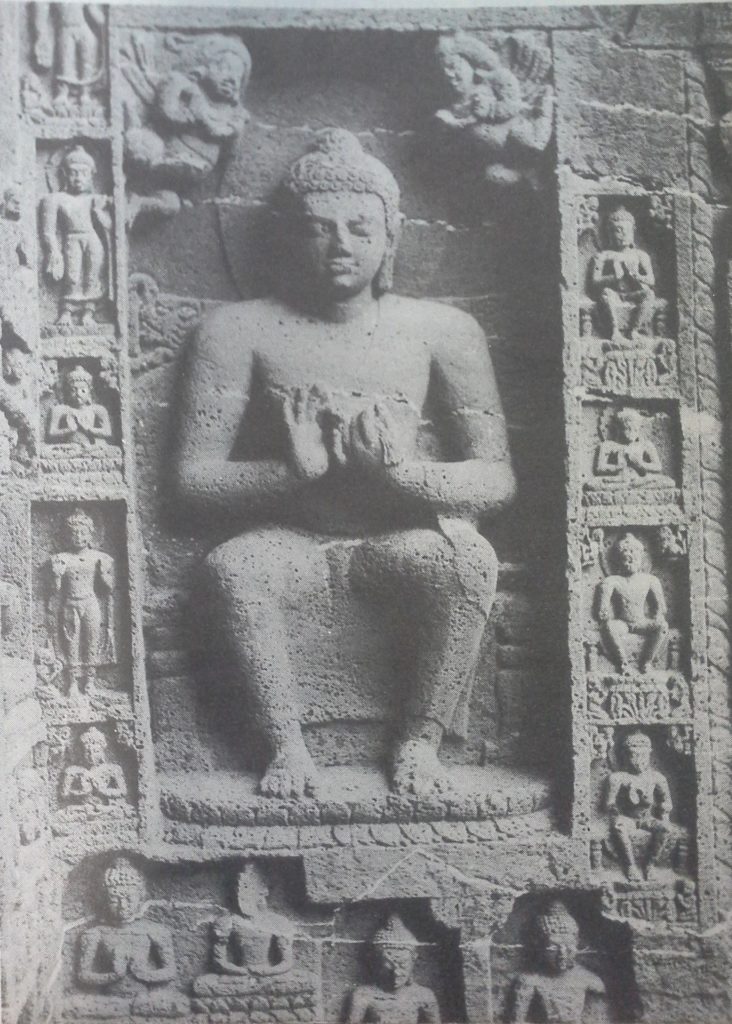
Alexander the Great brought Greek influences to India. Among the many invaders were the armies led by Alexander the Great. Alexander’s invasion of India was very brief (326-325 B.C.), nor did his troops push deeply into Indian territory. As elsewhere, this short period of Macedonian rule in the Indus valley had important results: (1) Greek ideas of architecture were planted in India, and (2) Greek writers wrote accounts of what they saw in India. From these accounts we get a picture of what India was like about 300 B.C.
India developed a great civilization under Asoka. Only a few years after Alexander’s invasion of India there began a great period in India’s early history. A famous ruling family, the Mauryas, brought all India except the southern tip together into a single empire. Greatest of the Mauryan kings was Asoka, who ruled from about 269 to 237 B.C. Asoka’s armies helped to create this vast empire, but the cruelty of war and bloodshed sickened him. Largely because of his many reforms, he is remembered today as a statesman and as a champion of peace rather than as a military leader.
Asoka was an intensely religious man who admired Buddha’s ideas. Under Asoka, Buddhism not only spread widely in India but was carried by missionaries westward to Egypt and northeastward far into east Asia. Although Asoka proclaimed Buddhism as the state religion, he did not interfere with the religious ideas of others. He said that all religious groups deserve to be respected.
Asoka possessed unlimited authority, but he used his power wisely. His interest in the welfare of the common people led him to improve living and working conditions. At his bidding wells were dug, trees planted, farming methods improved and steps taken to improve the care of the sick. Royal edicts, carved in many languages on pillars set up throughout his kingdom, directed the people to deal more charitably with one another. To this day, Asoka is remembered as one of India’s great men.
Soon after Asoka’s death, however, his empire broke up into smaller states. Several hundred troubled years followed before unity, peace and prosperity returned to India.
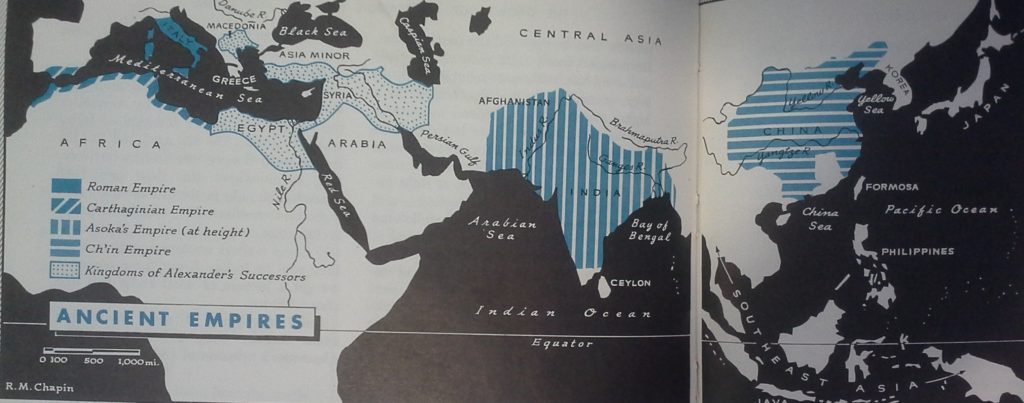
Indian civilization reached new peaks under the Guptas. Great as was India’s civilization in Asoka’s day, it was even more advanced under the rulers of the Gupta family. The Gupta empire was not as large as was the kingdom of Asoka, but included most of northern India. From about 300 to 500 A.D., India had a period of greatness much like that which Athens enjoyed under Pericles. Art and architecture flourished, great literature was produced and science advanced. Trade grew to such an extent that Indian goods, especially dyes and spices, were to be found in market places as far apart as Egypt and China.
It was during these same years that Buddhism lost ground in India. After Buddha’s death his followers neglected his teachings and began to worship him as a god and to adopt many elaborate ceremonies. Buddhism therefore declined because it was no Ionger the influence for good it once had been. Hinduism, with some change, again became the religion of the great majority of the Indian people.
New invasions kept India in disorder for centuries. By about 500 AD. this second period of peace and prosperity in India came to an end with new attacks from without. First came the White Huns, a people related to the Huns under Attila who had attacked the Roman Empire. Then other bands of raiders came down from the mountain passes in the northwest. By about 700 A.D., these raids had grown into full scale invasions. Arabs, Persians and savage tribesmen from central Asia pushed into northern India. Among the latter were Turks and Mongols. These invading groups fought not only against the people of India but also among themselves. Under these conditions progress slowed down and strong, lasting government for India became impossible.
The Turkish invaders who ruled India for several centuries made their capital at Delhi, in north central India but extended their authority far to the south. In time the power of the Turks was threatened by Mongol attacks. Particularly destructive was the great raid of the Mongol leader Tamerlane. Tamerlane swept into India in 1398 A.D., and though he remained but a year he left widespread destruction and confusion behind him. He sacked Delhi and caused a greater loss of life and property than any other conqueror. The Turkish rulers never fully recovered from their defeat at Tamerlane’s hands. Soon after 1500 AD. the Turks were overthrown by a new Mongol invasion which set up the Mogul (Persian for Mongol) Empire in India.
2. What Kind of Civilization Grew Up in Early India?
The early history of India, as you have seen, was one of constant invasions. Except when the Mauryas and Guptas were in control, India enjoyed no extended periods of peace and unity. Different invading groups not only kept India in confusion but destroyed many Indian buildings and works of art. Under constantly changing and often ruthless rulers, however, the Indian people continued their established ways of life.
Life in India provided sharp contrasts. India was a land of extremes. High caste members of the wealthy ruling class lived in luxury; low caste labourers and untouchables had little or no property and no voice in the government. While many were hungry a few feasted. Rajahs rode by in state while the masses of the people bowed low. The caste system and the form of government both helped to make the rich richer and the poor poorer.
Most of the population lived in villages. The great mass of the humble folk lived in small villages. Their little huts of mud with thatched roofs were crowded together on narrow streets. Water, often impure, was obtained from a few wells.Even today India is basically a land of villages and in many respects village life has not changed greatly since early times.
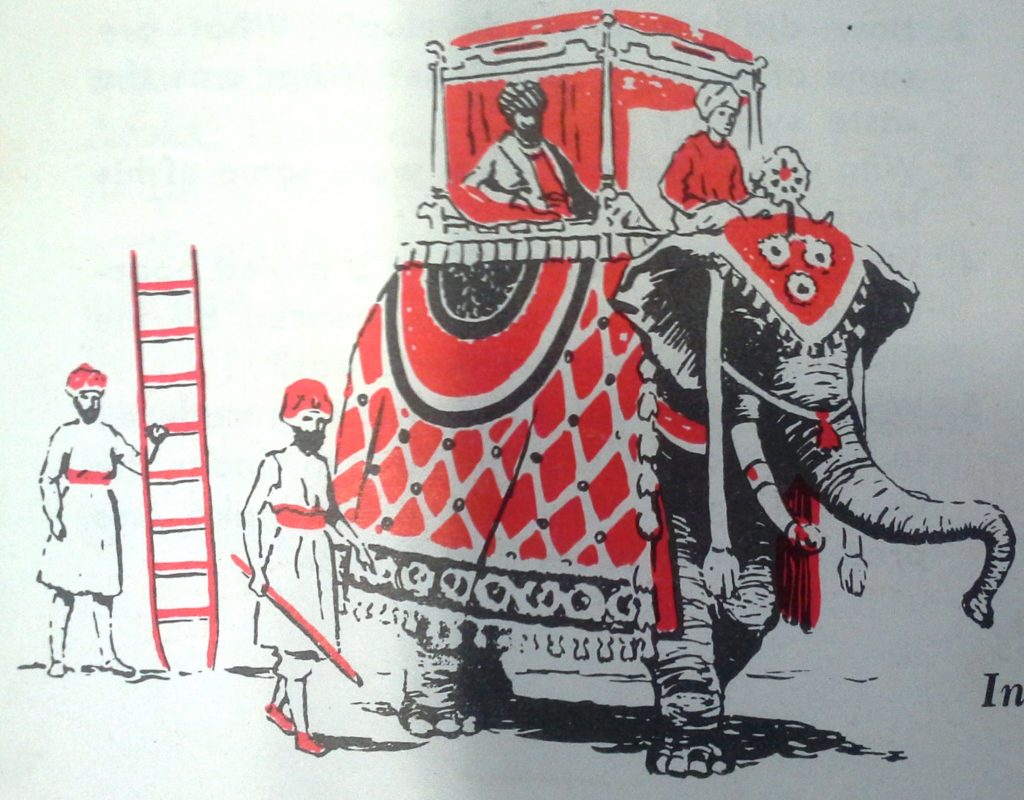
In general the villagers were low caste and caste rules were strictly observed. Each family, under the authority of the father, was closely united in its worship and in the care of its members. Food was scarce and consisted largely of grain, meat being forbidden by the Hindu faith. The chief occupation was farming. The average farmer struggled to eke out a scanty living by tilling the nearby fields with crude implements and with the help of oxen or water buffaloes.
Though some handicrafts such as spinning and weaving were carried on in the household, each village had its craftsmen who were specialists — the carpenter, the blacksmith and the metalworker. Goods were bartered (exchanged for other goods) rather than sold. Most of the people were hopelessly sunk in poverty, heavily taxed and continually in debt. Each village, however, despite its poverty, to a large extent managed its own local affairs.
Most people of wealth and rank lived in the cities. There was also a considerable city population in India. Through the centuries large, prosperous cities had grown up. Here resided the rajahs, whose immense wealth came from the taxes paid by their subjects. The government of the various Indian states was centralized in the hands of the rajahs. Even rulers of small states wielded unlimited power within their own territories. They lived in a lavish manner, employed many officials and played the part of great rulers.
Not only the rulers but the officials who served them had elaborate palaces with beautiful gardens. So did the city dwelling landlords who owned large country estates worked by tenant farmers. Also in the cities were centres for scholars and imposing public buildings and in cities the brisk trade of India was carried on.
Indian wares were much sought after in the West. From the time of Alexander the Great, the products of India were known to the Mediterranean world. At first these came overland by way of Persia and Mesopotamia, or by sea up the Persian Gulf and through Mesopotamia to Syria. Later, Greek, Roman and Arab seamen in search of rich cargoes sailed from the Red Sea or the east coast of Arabia to southern India and Ceylon. Cotton cloth manufactured in India was in great demand. Other articles of export were ivory, precious stones, spices and strange wild animals. India was also a market where Westerners could buy Chinese silks. In return, the Indians imported copper, lead, tin, glass and wines, but they exported far more than they bought; the difference was made up by payments of gold and silver coin. In recent times large hoards of Roman coins have been found at various points in southern India.
For some centuries during the later invasions, India was cut off from direct contact with European peoples. A few merchants and missionaries from western Europe found their way overland between 1200 and 1500 AD. Most of those contacts were not important. Only when a sea route to India was discovered in 1498 did Western influence again begin to affect India.
Early India developed a high level of civilization. The great mass of Indian people led lives of ceaseless toil and hardship, they had neither the time nor the opportunity to develop an interest in art or learning. Yet early India was not without its scholars and learned men. It was chiefly through their efforts that India developed so high a level of civilization.
The literature, science, and art which Indian scholars created showed the influence of invading peoples as well as of outside groups with which India had come in contact. The Prakrit language, brought by the early Indo-Aryans, became the foundation for Sanskrit and other Indian languages. In the same way, an alphabet probably introduced from Arabia about 600 B.C. became the basis for later Indian alphabets.
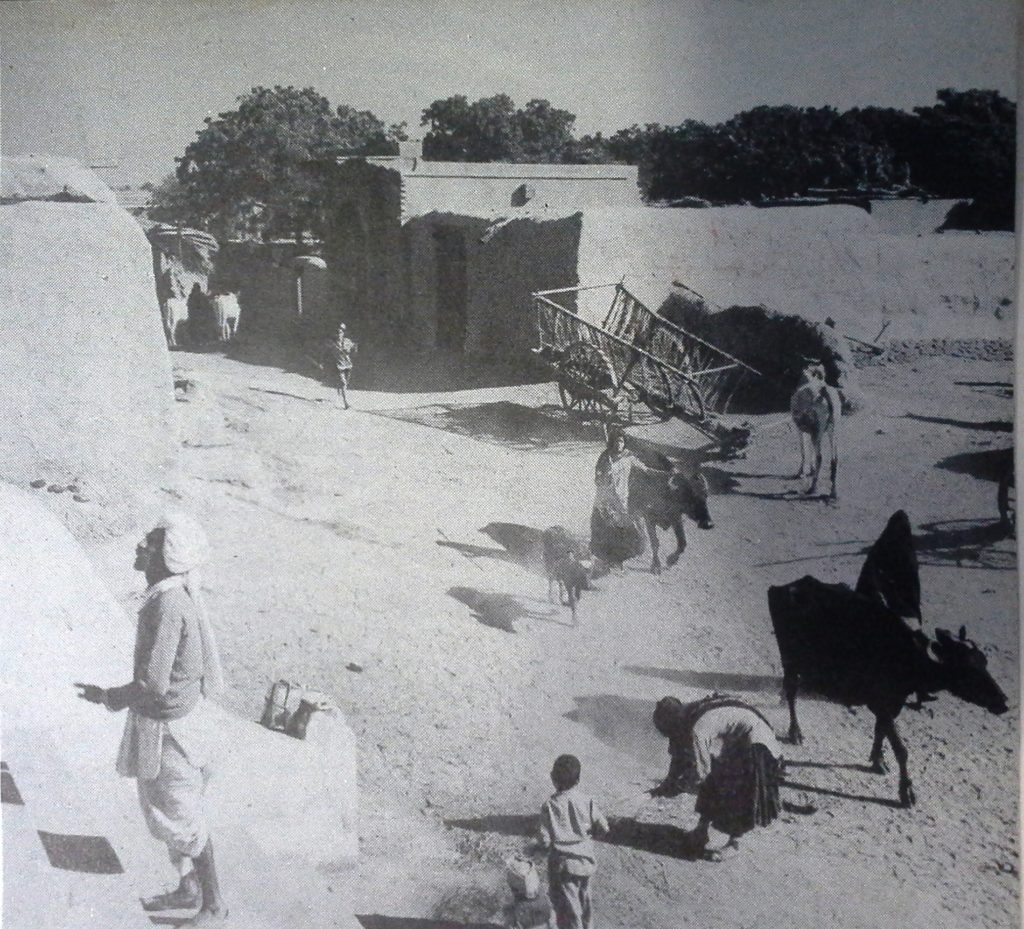
Religion influenced Indian culture. Most early Indian art and learning reveals a strong interest in religion. As might be expected, this religious interest stemmed largely from Hinduism. However, even though Buddhism ceased to he an important religion in India after 800 A.D., it left a deep impression on Indian thought and learning. Still another religious influence on Indian art and learning came from invaders between 700 and 1500 A.D. Most of these peoples followed another of the world’s great religions; Mohammedanism. So far apart were Hinduism and Mohammedanism in what they taught that the followers of neither religion could accept the faith of the other. The two faiths therefore continued to exist side by side.
Schooling was limited to the more fortunate. India had no system of public schools, so most of the working people could neither read nor write. Education for girls and women was frowned upon, but opportunities for study and instruction were open to boys of the upper castes and the more well to do families. Sometimes they were taught by schoolmasters in the larger villages and cities. Sometimes they studied with Brahmin or Buddhist priests in religious schools connected with temples or monasteries. Over the centuries, therefore, a good sized educated class developed in India.
In addition to reading, writing, and mathematics, pupils studied the Hindu Vedas. They read and discussed the words of Buddha as set down by his followers. The very capable student might go on to one of the universities for advanced study.
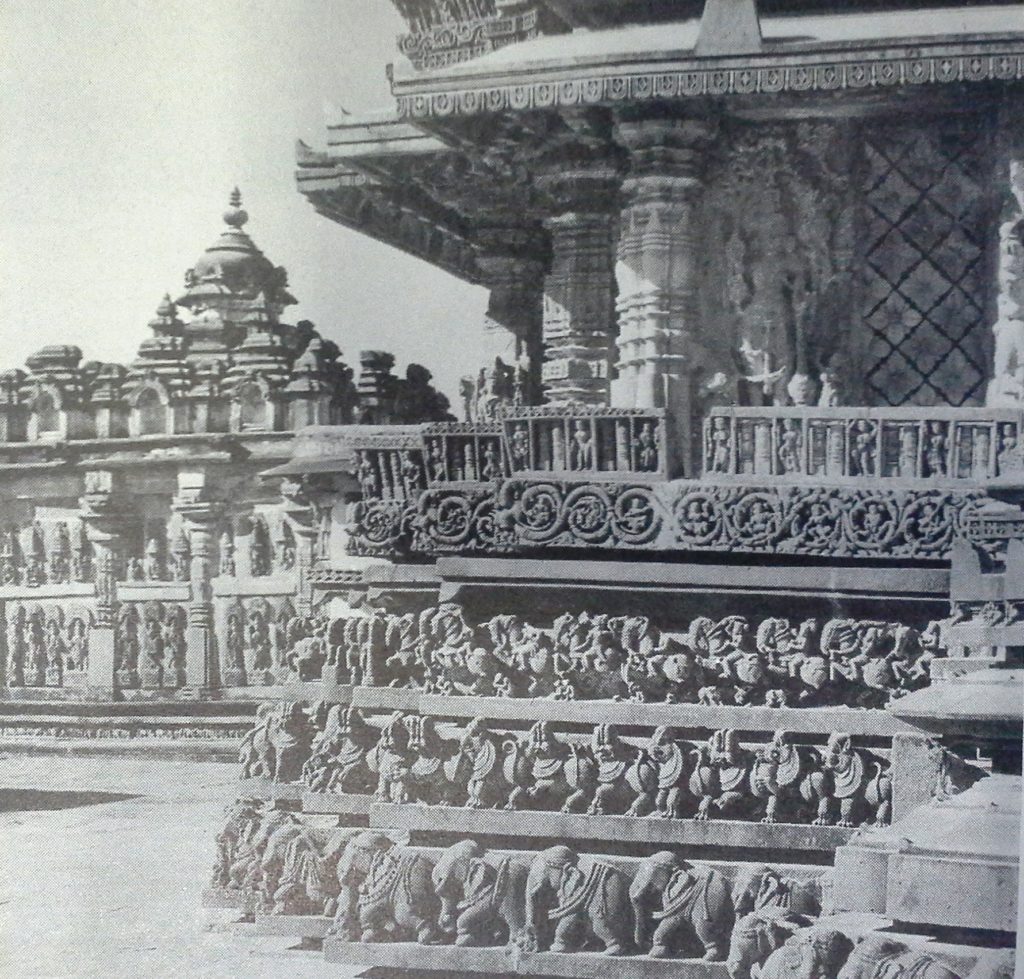
Indian scholars increased the world’s store of knowledge. Although Indian education dealt chiefly with religious subjects, learned men also concerned themselves with various fields of science and mathematics. A traveler in India about 1100 A.D., found Sanskrit books containing Greek and Roman ideas of astronomy. Indian astronomers developed a calendar, could foretell eclipses of the sun and moon; and had ideas about the force of gravity. Indian physicians made progress in surgery and in the use of herbs to cure diseases. Hindu scientists were also familiar with chemistry. Their knowledge in this field made it possible for craftsmen to tan leather, dye cloth and produce soap, cement, glass and finely-tempered steel.
It was in mathematics, however, that Indian scientists made their greatest contributions. What we call arabic numerals (l, 2, 3, etc.) were actually used first in India, not Arabia. The Indians also introduced the decimal system and the symbol for zero. Geometry was studied in India as early as 600 B.C. Algebra developed in India as well as among the Arabs. For centuries Indians used an arithmetic textbook called the Lilivati. Oddly enough, this is a girl’s name. According to the legend, a famous mathematician of the 1100’s A.D., wrote this book for his beautiful daughter, Lilivati, whom he loved dearly. Her name appears in it frequently and many of the explanations are directed to her.
India produced a varied literature. Indian writers developed many kinds of literature. There were popular tales about Indian life and animals as well as love stories, poems and plays. One of the greatest of India’s writers was Kalidasa, who lived during the glorious days of the Gupta rulers. Kalidasa’s poems and plays rank with the best that the ancient Greeks wrote. Later on, the Arab invaders introduced the writing of history, so that we have good accounts of the later invasions. For the most part, Indian literature had to do with religion. Many writings dealt with religious ceremonies and explained Brahmin and Buddhist ideas about man and the world in which he lives.
Indian art and architecture were chiefly religious. The greatest works of architecture in old India were temples, monasteries and shrines in caves. For important buildings, stone came into use in place of mud bricks about Asoka’s time. Later on, temples became larger and more imposing. They frequently included large courts surrounded by columned porches and lofty towers. Some of the royal palaces were elaborate buildings of stone.
Temples and other sacred buildings were richly decorated with great numbers of human and animal figures. Carved in relief, they illustrated religious scenes or ideas. At first sculptors in India were greatly influenced by Greek sculptors, but by about 200 AD. they had developed their own styles of art in stone. Buddhist sculptors produced beautiful stone figures of Buddha, usually shown in an attitude of deep thought. In describing these statues of Buddha, India’s modern statesman Jawaharlal Nehru says:
His eyes are closed, but some power of the spirit looks out of them. . . . The ages roll by and Buddha seems not so far away after all; his voice whispers in our ears and tells us not to run away from the snuggle but, calm-eyed, to face it and to see in life ever greater opportunities for growth and advancement.
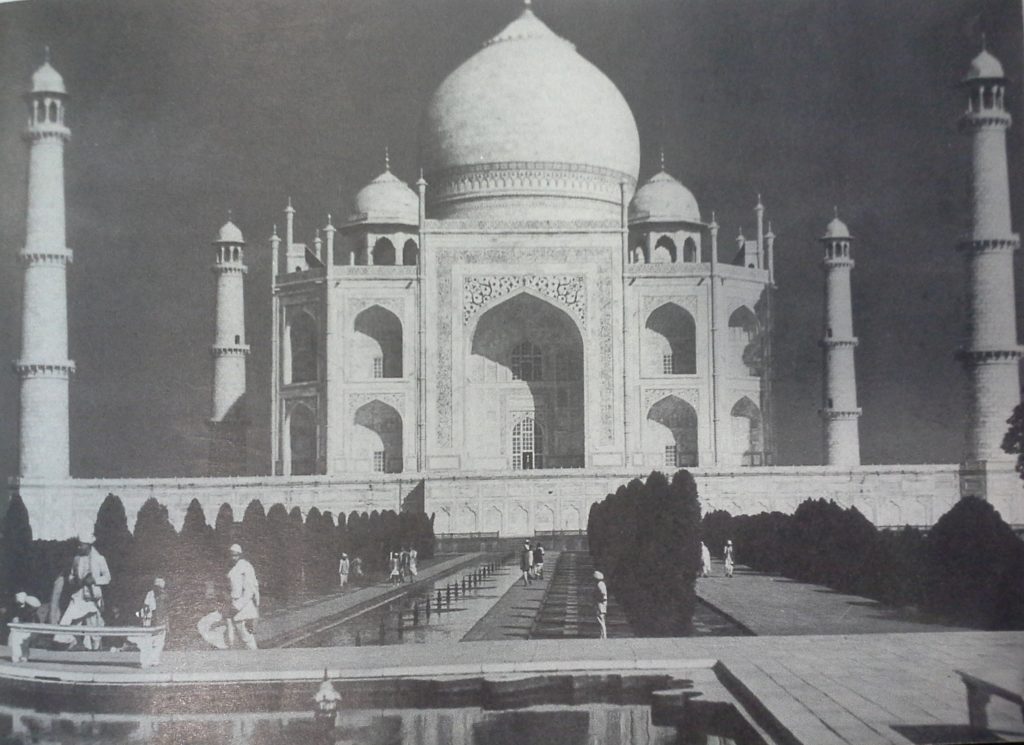
When Moslem peoples invaded India, they destroyed much of old India’s sculpture and architecture, but brought new architectural ideas of their own. The Taj Mahal, a graceful, stately tomb erected in the 1600’s, is an outstanding example.
Indian artists painted pictures on temple walls and in caves. Artists also illuminated manuscripts. As religious ideas were carried eastward from India into China and other parts of Asia, India’s ancient art and architecture spread, too. India, in truth, is one of the mothers of civilization.
